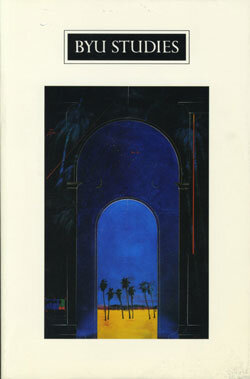Landscapes of the Mind
A Portfolio of Paintings by Wulf E. Barsch
Article
-
By
Wulf E. Barsch,
Contents
Wulf E. Barsch is a professor of art at Brigham Young University. He once called his paintings “landscapes of the mind,”1 and they are certainly that: symbolic, archetypal, brooding—and strikingly beautiful. Between 1966 and 1989 he mounted fourteen solo exhibitions and took part in 144 group exhibitions, including a 1969 solo exhibition at the Galerie Werkkunstschule, Hannover, West Germany; the 1983 Thirty-eighth Corcoran Biennial Exhibition of American Painting; and a 1986 exhibition at the Museu de Arte Moderna, Rio de Janeiro, Brazil. His works hang in thirty-five permanent collections, including those at the Library of Congress, Washington, D.C.; the Museu de Arte Moderna, Rio de Janeiro, Brazil; and the States Senate, Hamburg, West Germany. He received the 1975–76 Prix de Rome in painting, from the American Academy in Rome, Italy, and had two paintings chosen for the 1986 United States Department of State Art in Embassies Program. His works are reproduced in at least thirty-four catalogs and books. Brigham Young University Studies is pleased to reproduce six of his paintings in this issue.
Hugh W. Nibley writes of Barsch’s paintings: “There is nothing trivial, contrived, clever or cute about them; they seem more like a solemn summing-up, with something of both suspense and finality about them. . . . His work [has] deep sincerity that demands to be taken seriously. Strangely enough, with all his moving solemnity I find some of his things intensely romantic. The constant dialogue of the poplar and the palm is right out of the most ancient traditions of romantic poetry, whether Barsch is aware of it or not, with echoes from the Patriarchal Romances of Genesis. The poplar is the tree of the pioneers, marking their farms on all the benches and valleys from the red sands of Moencopi to the plains of Alberta. It is becoming rare as business supplants the noble windbreaks with billboards. And the palm evokes the wandering tribes of Israel . . . for it is their hope and succor in the desert.”2
[*** graphic omitted ***]
Wulf E. Barsch, Template, oil on canvas, 60 by 48 inches.
[*** graphic omitted ***]
Wulf E. Barsch, Template for Adamantina, oil on canvas, 36 by 72 inches.
[*** graphic omitted ***]
Wulf E. Barsch, The Gate, oil on canvas, 60 by 90 inches.
[*** graphic omitted ***]
Wulf E. Barsch, Template II, oil on canvas, 48 by 62 inches.
Notes
1. E. Frank Sanguinetti, In the Desert—A Stranger in a Strange Land (Salt Lake City: Paragon Press, [1983]), 2.
2. Wulf Barsch: Looking toward Home, catalog for Looking toward Home: Recent Art by Wulf Barsch, an exhibition at the Museum of Church History and Art, Salt Lake City, 22 November 1985 to 13 April 1986 (Salt Lake City: Museum of Church History and Art, 1985), [xii–xiii].
- In Praise of Ourselves: Stories to Tell
- Landscapes of the Mind: A Portfolio of Paintings by Wulf E. Barsch
- Towards a Critical Edition of the Book of Mormon
- Thomas Bullock as an Early Mormon Historian
Articles
- In Search of the Republic
- Mr. Wahlquist in Yellowstone and Other Stories
- History and Faith: Reflections of a Mormon Historian
- Samuel Claridge: Pioneering the Outposts of Zion
- Quest for Refuge and Exiles in a Land of Liberty
- The Life Before
- The Company We Keep: An Ethics of Fiction
- A Sermon in the Desert: Belief and Behavior in Early St. George, Utah
- Religious Seekers and the Advent of Mormonism
Reviews
Purchase this Issue
Share This Article With Someone
Share This Article With Someone
Print ISSN: 2837-0031
Online ISSN: 2837-004X


